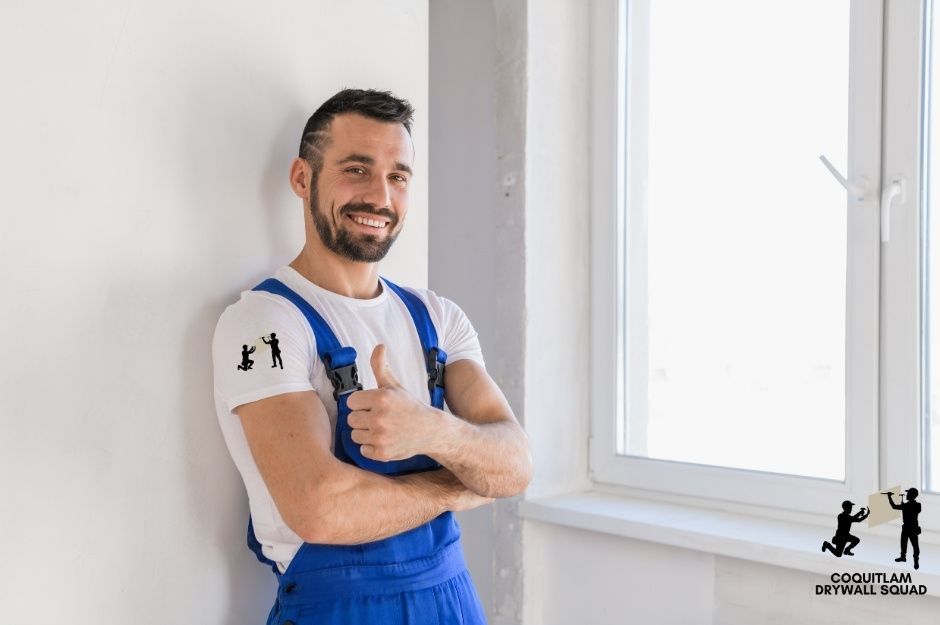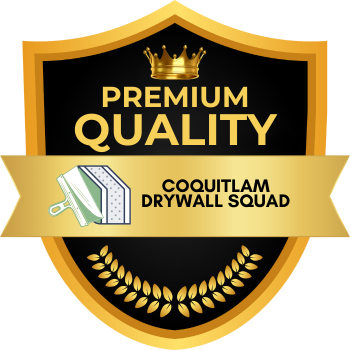Drywall Repair Surrey
High-quality Sheetrock Repair Company in Surrey, British Columbia

Professional drywall repair services at Coquitlam Drywall Squad in Surrey, BC address all your wall and ceiling needs, from minor patches to complete installations. Contractors provide comprehensive solutions including hole repairs, crack filling, water damage restoration, popcorn ceiling removal, and corner bead fixes - ensuring your walls maintain both structural integrity and visual appeal.
As British Columbia's second-largest city by population with over 568,000 residents, Surrey's diverse neighborhoods from Cloverdale to Whalley City Centre require specialized drywall expertise to handle everything from heritage home renovations to modern commercial developments.
Whether you need a small patch job or full drywall installation, Surrey's experienced technicians use industry-leading techniques and quality materials. Your damaged walls receive careful attention through specialized repair methods that seamlessly blend repaired areas with existing surfaces. Given Surrey's oceanic climate with average annual precipitation of 1,399 mm, local contractors are particularly skilled at addressing moisture-related drywall issues common in the Pacific Northwest region.
Surrey drywall specialists handle residential and commercial projects with precision and skill. You can trust local experts to deliver durable, attractive results while maintaining clean workspaces and efficient project timelines.

Coquitlam Drywall Squad

Expert Drywall Repair Services in Surrey, British Columbia
Professional drywall repair services in Surrey tackle a wide range of wall and ceiling damage issues. Local contractors use specialized techniques and materials to restore damaged surfaces to their original condition. With Surrey's rapid growth since the 1980s and 1990s, many homes built during this expansion era now require drywall maintenance and updates to meet modern standards.
Patch a Hole in Drywall
Small holes from doorknobs or picture hooks can be repaired with mesh tape and joint compound. For larger holes, you'll need a drywall patch or new section of drywall cut to size.
Professional repairs involve cleaning the damaged area, installing backing support, and applying multiple coats of compound. Each layer must dry completely before sanding.
Surrey Climate Considerations: With winter temperatures averaging 3.8°C and high humidity levels, drying times for joint compounds may extend beyond the typical 24-hour period. Professional contractors account for Surrey's wet winters when scheduling multi-coat repairs.
Common hole repair materials:
- Self-adhesive mesh tape
- Joint compound
- Sanding blocks
- Drywall patches
- Utility knife
Texture matching is crucial for a seamless finish. Professionals use specialized tools to replicate your existing wall texture pattern.
Repairing Cracks in Ceilings
Ceiling cracks often result from house settling or structural movement. Early repair prevents further damage and maintains ceiling integrity. Surrey's location along the Fraser River on generally flat terrain means most structural settling occurs in the first few years after construction, particularly in areas like Tynehead and South Surrey where flatland development is common.
The repair process starts with widening the crack slightly and removing loose material. Fiber tape provides reinforcement before applying joint compound.
Key steps for ceiling crack repair:
- Clean the crack area
- Apply fiber tape
- Layer joint compound
- Sand between coats
- Match existing texture
Popcorn Ceiling Repair Techniques
Damaged popcorn texture requires careful matching to blend with surrounding areas. The process begins with scraping away loose material and applying a bonding agent. Many Surrey homes built during the suburban expansion of the 1950s and 1960s feature popcorn ceilings, making this a particularly common service request in established neighborhoods like North Surrey and parts of Newton.
New texture is applied using specialized spray equipment. The mix must match the original texture size and pattern.
For water-stained areas, a stain-blocking primer prevents discoloration from bleeding through. Fresh texture should extend slightly beyond the repair area for proper blending.
Water Damage Restoration
Water damage requires immediate attention to prevent mold growth. The first step is identifying and fixing the water source. Surrey's high annual rainfall of 1,360.8 mm and frequent winter storms make water intrusion a common concern, especially in areas prone to Fraser River flooding and homes with poor drainage systems.
Moisture-resistant drywall replacement may be necessary for severely damaged areas. Professionals use moisture meters to determine the full extent of water penetration.
Water damage repair process:
- Remove wet materials
- Dry the area completely
- Install moisture-resistant drywall
- Apply mold-resistant primer
- Match existing texture and paint
Professional dehumidification equipment speeds drying and prevents future issues.
Comprehensive Ceiling and Joint Repairs
Professional drywall repairs require precise techniques and specialized tools to restore damaged ceilings and joints to their original condition. Skilled contractors implement proven methods to fix water damage, cracks, and structural issues while ensuring seamless results. Surrey's designation of 27% of its land area (approximately 2,465 hectares) as Agricultural Land Reserve means many residential properties border farming areas where soil conditions can affect home settling patterns and subsequent drywall issues.
Ceiling Repair Solutions
Water-damaged ceilings demand immediate attention to prevent further deterioration and potential collapse. Begin by identifying and fixing the water source before addressing the drywall damage.
For small ceiling cracks, contractors apply joint compound and reinforcing tape to create a durable repair. Larger damage may require cutting out and replacing affected sections with new drywall.
Popcorn ceiling repairs involve carefully matching existing texture patterns. Contractors first scrape away loose material, apply fresh compound, and recreate the texture using specialized tools. In Surrey's seven designated town centres - Cloverdale, Fleetwood, Guildford, Newton, South Surrey, Whalley City Centre, and Surrey City Centre - older commercial buildings often require specialized ceiling repairs due to age and heavy foot traffic.
Corner Bead Replacement and Repair
Corner bead damage typically occurs from impact and requires careful attention to maintain straight wall edges. Damaged metal or vinyl corner beads must be removed completely to ensure proper repair.
Installation of new corner bead requires precise alignment and secure fastening. Contractors use joint compound to feather the edges, creating smooth transitions between walls.
Common Corner Bead Issues:
- Dents from furniture impact
- Separation from drywall
- Rust on metal beads (particularly common in Surrey due to high humidity levels)
- Cracked joint compound
Joint Tape and Compound Application
Proper joint repair starts with cleaning the affected area and removing loose tape or compound. Fresh joint tape must be centered over seams and embedded in a thin layer of compound.
Three-Step Joint Compound Process:
- Base coat: Embed tape and fill major gaps
- Second coat: Cover tape and feather edges
- Final coat: Smooth finish and blend with wall surface
Allow each layer to dry completely before applying subsequent coats. Sand between layers for optimal smoothness and professional results.
Drywall Installation and New Construction Solutions
Professional drywall installation requires precise measurements, proper materials, and expert techniques to create smooth, durable walls and ceilings. Skilled contractors in Surrey deliver high-quality results for both new construction and renovation projects. With Surrey projected to become BC's most populous city within the next decade, the demand for new construction drywall services continues to grow, particularly in developing areas like South Surrey and Fleetwood.
Sheetrock Installation Process
Start by measuring and marking your wall spaces to determine the required drywall sheets. Plan the layout to minimize seams and waste.
Install proper framing and insulation before hanging any sheets. Ensure studs are straight and properly spaced at 16 or 24 inches on center. Surrey's building codes, influenced by Metro Vancouver regional standards, require specific insulation R-values due to the area's oceanic climate with winter lows averaging 0.9°C.
Secure drywall sheets using appropriate screws at 12-inch intervals along studs. Pay special attention to corners and joints.
Key Installation Steps:
- Cut sheets to size using a utility knife and T-square
- Install ceiling drywall before walls
- Place electrical box cutouts precisely
- Apply corner beads for protection
- Tape and mud joints in multiple layers
Choosing the Right Materials for New Drywall
Select moisture-resistant drywall for bathrooms and basements. Standard 1/2-inch drywall works well for most walls, while 5/8-inch fire-rated drywall is required for garage walls and ceilings. Surrey's proximity to the US border at Peace Arch means materials are often sourced from both Canadian and American suppliers, giving contractors access to competitive pricing and specialized products.
Common Drywall Types:
- Regular gypsum board
- Moisture-resistant (green board) - essential for Surrey's high-humidity environment
- Fire-resistant (Type X)
- Soundproof drywall - increasingly popular in Surrey's dense urban developments
Consider factors like room usage, local building codes, and sound requirements when selecting materials.
Drywall Services for Residential and Commercial Spaces
Your residential project might require specialized solutions like soundproofing for media rooms or moisture resistance for bathrooms. Surrey's diverse population, with significant Asian communities established since the 1980s, has created demand for custom residential layouts requiring specialized drywall configurations.
Commercial spaces often need fire-rated drywall systems and specific acoustic treatments. Surrey contractors handle both small home renovations and large commercial builds. Major commercial developments in Surrey City Centre and along King George Boulevard require contractors familiar with Metro Vancouver's commercial building standards.
Services Include:
- New home construction
- Office build-outs
- Retail space renovations
- Multi-unit residential projects (common in Surrey's growing condo market)
- Tenant improvements
Professional contractors bring appropriate crews and equipment sized to your specific project needs.
Professional Drywall Finishing Techniques
Proper drywall finishing requires meticulous attention to detail and specialized techniques to achieve smooth, seamless surfaces. Professional contractors use specific tools and methods to create flawless walls that stand the test of time. Surrey's status as a bedroom community for Vancouver and Burnaby commuters means many homeowners prioritize quality finishes that maintain property values in this competitive real estate market.
Mudding and Taping Methods
Start by applying a base coat of joint compound with a 6-inch drywall knife to embed paper tape over seams. Press firmly to remove air bubbles and excess compound.
Apply second and third coats using progressively wider knives (8-inch, then 12-inch). Each coat should extend 2-3 inches beyond the previous layer to create a gradual taper.
Essential Tools:
- Joint compound
- Paper or mesh tape
- Various sizes of drywall knives
- Mud pan
- Corner tools
Let each coat dry completely before sanding - typically 24 hours in normal conditions. During Surrey's rainy season (October through March with over 180mm monthly precipitation), contractors often use dehumidifiers and fans to maintain proper drying conditions.
Expert Drywall Sanding Practices
Use 150-grit sandpaper for initial sanding between coats. Switch to 220-grit for final smoothing.
Mount your sanding screen to a pole sander for ceilings and high walls. Hand sanders work best for detail areas and corners.
Pro Tips:
- Sand in a circular motion
- Wear proper respiratory protection (especially important in Surrey's older homes that may contain asbestos)
- Use adequate lighting to spot imperfections
- Feel the surface with your hand to detect bumps
Seamless Blending with Texture Matching
Sample the existing texture pattern using clear tape to capture the detail. Match the technique using the appropriate tools - spray gun, knockdown knife, or texture brush. Historical Surrey homes in areas like Cloverdale, established in 1879, often feature unique textures that require specialized matching techniques due to their heritage construction methods.
Mix joint compound to the right consistency for your texture style. Test the pattern on a scrap piece first.
Common texture types:
Orange peel
Knockdown
Skip trowel
Popcorn ceiling (prevalent in Surrey's post-war single-family developments)
Apply texture in thin layers, allowing partial drying between coats for optimal control and matching. Surrey's moderate summer temperatures averaging 17.9°C provide ideal conditions for texture application, while contractors must adjust techniques during the cooler, wetter months.
